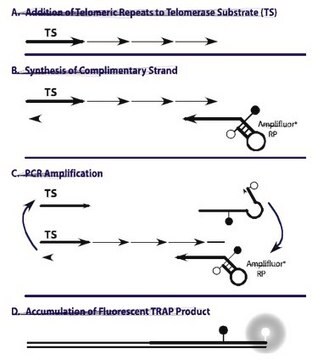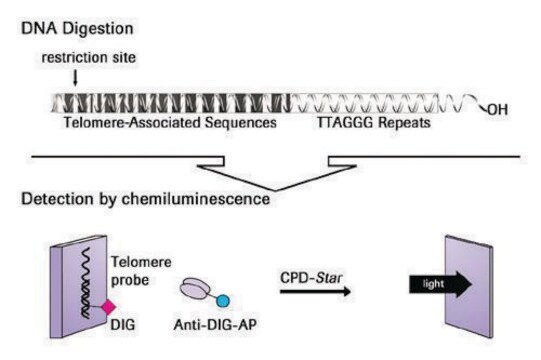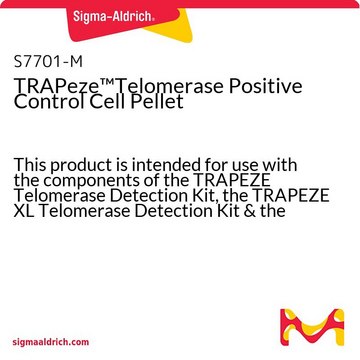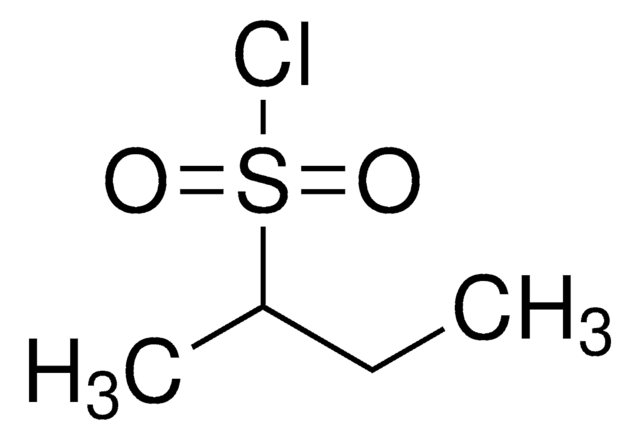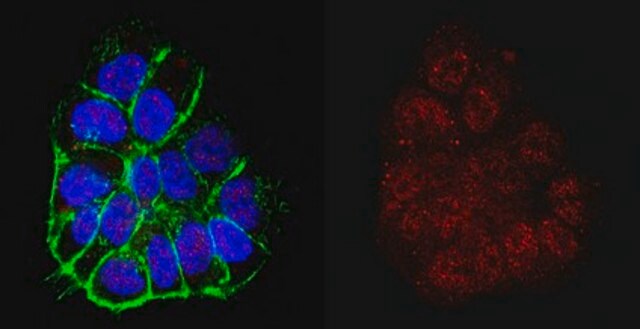S7700-M
TRAPeze™ Telomerase Detection Kit
Iniciar sesiónpara Ver la Fijación de precios por contrato y de la organización
About This Item
Código UNSPSC:
12161503
eCl@ss:
32161000
NACRES:
NA.84
Productos recomendados
Descripción general
Telomeres are specific structures found at the ends of chromosomes in
eukaryotes. In human chromosomes, telomeres consist of thousands of copies of 6 base repeats (TTAGGG). It has been suggested that telomeres protect chromosome ends, because damaged chromosomes lacking telomeres undergo fusion, rearrangement and translocation. In somatic cells, telomere length is progressively shortened with each cell division both in vivo and in vitro, due to the inability of the DNA polymerase complex to replicate the very 5′ endof the lagging strand .
Telomerase is a ribonucleoprotein that synthesizes and directs the telomeric
repeats onto the 3′ end of existing telomeres using its RNA component as a
template. Telomerase activity has been shown to be specifically expressed in immortal cells, cancer and germ cells, where it compensates for telomere shortening during DNA replication and thus stabilizes telomere length. These observations have led to a hypothesis that telomere length may function as a “mitotic clock” to sense cell aging and eventually signal replicative senescence or programmed cell death. Therefore, expression of telomerase activity in cancer cells may be a necessary and essential step for tumor development and progression. The causal relationship between expression of telomerase and telomere length stabilization and the extension of the life span of the human cell has recently been reported.
eukaryotes. In human chromosomes, telomeres consist of thousands of copies of 6 base repeats (TTAGGG). It has been suggested that telomeres protect chromosome ends, because damaged chromosomes lacking telomeres undergo fusion, rearrangement and translocation. In somatic cells, telomere length is progressively shortened with each cell division both in vivo and in vitro, due to the inability of the DNA polymerase complex to replicate the very 5′ endof the lagging strand .
Telomerase is a ribonucleoprotein that synthesizes and directs the telomeric
repeats onto the 3′ end of existing telomeres using its RNA component as a
template. Telomerase activity has been shown to be specifically expressed in immortal cells, cancer and germ cells, where it compensates for telomere shortening during DNA replication and thus stabilizes telomere length. These observations have led to a hypothesis that telomere length may function as a “mitotic clock” to sense cell aging and eventually signal replicative senescence or programmed cell death. Therefore, expression of telomerase activity in cancer cells may be a necessary and essential step for tumor development and progression. The causal relationship between expression of telomerase and telomere length stabilization and the extension of the life span of the human cell has recently been reported.
The TRAPeze Telomerase Detection Kit is a highly sensitive in vitro assay system for detecting telomerase activity. The assay is a one-buffer, two-enzyme, system utilizing PCR to enhance the sensitivity of telomerase detection in small samples.
Recommended Taq polymerases: must be non-proofreading, having no exonuclease activity and capable of "hot-start." Titanium Taq, Platinum Taq are suggested.
Recommended Taq polymerases: must be non-proofreading, having no exonuclease activity and capable of "hot-start." Titanium Taq, Platinum Taq are suggested.
Información legal
TRAPEZE is a trademark of Merck KGaA, Darmstadt, Germany
Cláusula de descargo de responsabilidad
Unless otherwise stated in our catalog or other company documentation accompanying the product(s), our products are intended for research use only and are not to be used for any other purpose, which includes but is not limited to, unauthorized commercial uses, in vitro diagnostic uses, ex vivo or in vivo therapeutic uses or any type of consumption or application to humans or animals.
Código de clase de almacenamiento
10 - Combustible liquids
Certificados de análisis (COA)
Busque Certificados de análisis (COA) introduciendo el número de lote del producto. Los números de lote se encuentran en la etiqueta del producto después de las palabras «Lot» o «Batch»
¿Ya tiene este producto?
Encuentre la documentación para los productos que ha comprado recientemente en la Biblioteca de documentos.
Nuestro equipo de científicos tiene experiencia en todas las áreas de investigación: Ciencias de la vida, Ciencia de los materiales, Síntesis química, Cromatografía, Analítica y muchas otras.
Póngase en contacto con el Servicio técnico